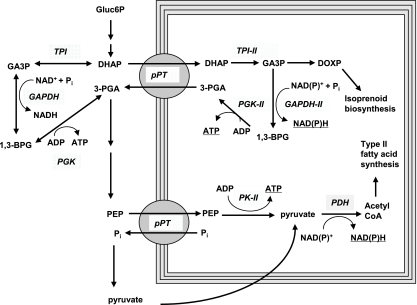FIG. 8.
Putative pathways for import of carbon into the apicoplast and generation of ATP and reduction power for fatty acid synthesis. The triose phosphate DHAP is transported from the cytosol into the apicoplast by the pPT and converted into 3-PGA by the action of TPI II, a putative apicoplastidic GAPDH II, and PGK II. The relocation of these central glycolytic reactions into the apicoplast would lead to a net transfer of ATP (via PGK II) and the reduction power (via GAPDH II) from the cytosol to the apicoplast. 3-PGA is proposed to leave the apicoplast via the PT and is, in the cytosol, either converted back into DHAP, thereby forming a reverse triose phosphate-3-PGA shuttle, or converted into PEP and pyruvate, which are then reimported into the apicoplast by the pPT or by a so-far-unknown plastid pyruvate transporter. Inside the apicoplast, PEP and ADP can be converted by PK into pyruvate and ATP.

